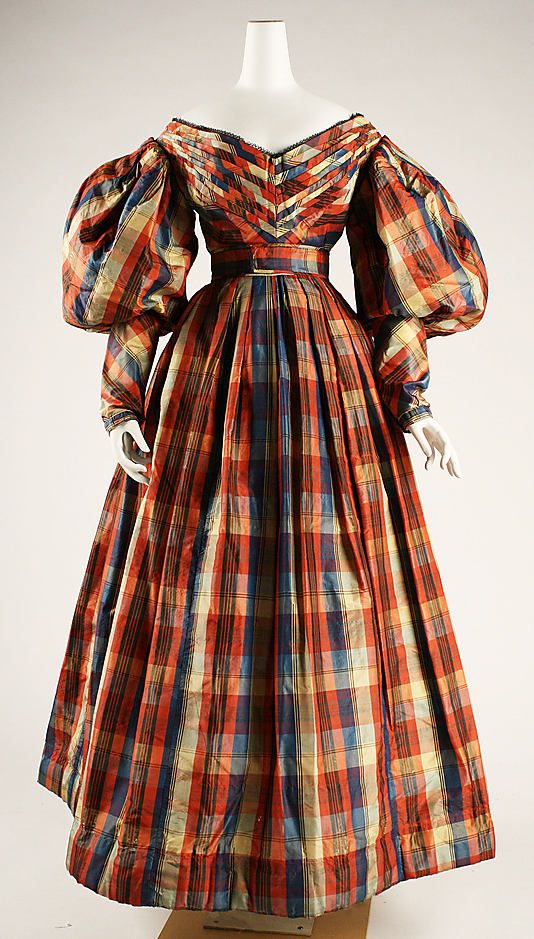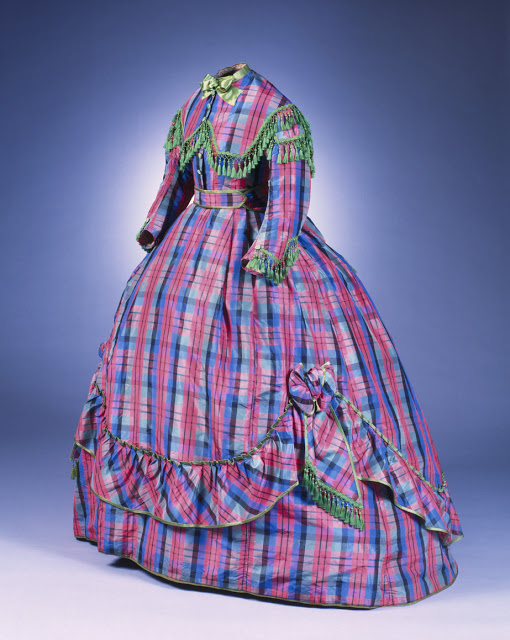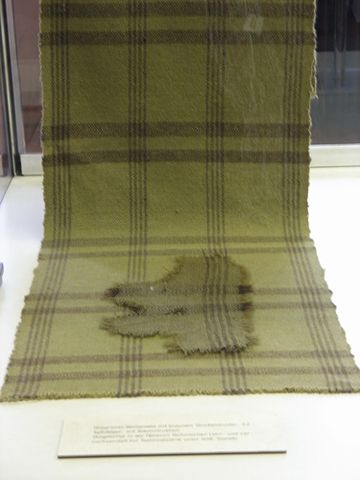
1 - Welcome to tonight's #Treadtalk.
#Velvet may bring to mind 1970s couches, or your 90s goth stage, but that's a long way from its luxurious roots.
So let's brave the Black Plague, the cold, and questionable fashion choices together, in the name of this truly royal fabric.
#Velvet may bring to mind 1970s couches, or your 90s goth stage, but that's a long way from its luxurious roots.
So let's brave the Black Plague, the cold, and questionable fashion choices together, in the name of this truly royal fabric.

2 - As with many fabrics, there is debate as to where velvet began. Some say China, others say Egypt & others point to the Middle East.
What they can agree on is that it’s a pain in the ass to make and $$$$$ AF. Original velvet was silk, too.
What they can agree on is that it’s a pain in the ass to make and $$$$$ AF. Original velvet was silk, too.

3 - Velvet is a pile fabric, which means it relies on lots of sharp objects & a touch of violence for production.
Yup! Velvet’s pile yarn is on the warp direction & must be cut on the loom or, in face-to-face methods--slicing down the middle to create two mirror-like textiles.


Yup! Velvet’s pile yarn is on the warp direction & must be cut on the loom or, in face-to-face methods--slicing down the middle to create two mirror-like textiles.



4 - When velvet is cut on the loom itself, it's done with steel slicing rods.
I watched this video on loop for like 20 minutes last night. I cannot stress enough >> SOUND ON<<.
Go watch. Come back. I'll still be here.
I watched this video on loop for like 20 minutes last night. I cannot stress enough >> SOUND ON<<.
Go watch. Come back. I'll still be here.
5 - This process of cutting or shaving the loops is what makes velvet so soft & visually stunning.
It creates a high density surface that absorbs & reflects light; dyes saturate in truly remarkable ways, but the fabrics also shimmer. (Panel 13th-14th century Iran, below)
It creates a high density surface that absorbs & reflects light; dyes saturate in truly remarkable ways, but the fabrics also shimmer. (Panel 13th-14th century Iran, below)

6 - The pile is also its weakness. Though we know there were examples of pile weaves similar to velvet dating to around 2000 BCE, they are few.
Since the threads are shaved & “open”, over time they wear away. Like this gorgeous hat from India. You can see the patches.
Since the threads are shaved & “open”, over time they wear away. Like this gorgeous hat from India. You can see the patches.

7 - Yet, because velvet is saucy like that, playing upon wear can make for some damn fine patterns, like in this late 18th century court suit.
It’s got cut & uncut velvet which makes the pattern on the silk. There are MANY kinds of velvet that play with these sorts of features.

It’s got cut & uncut velvet which makes the pattern on the silk. There are MANY kinds of velvet that play with these sorts of features.


8 - If you’re a #threadtalks follower, you’ll know that it’s no surprise that the Renaissance heralded in the biggest velvet mania, but how that happened wasn’t a straight line.
These lovely ladies are rocking the black velvet like it's 1599.

These lovely ladies are rocking the black velvet like it's 1599.

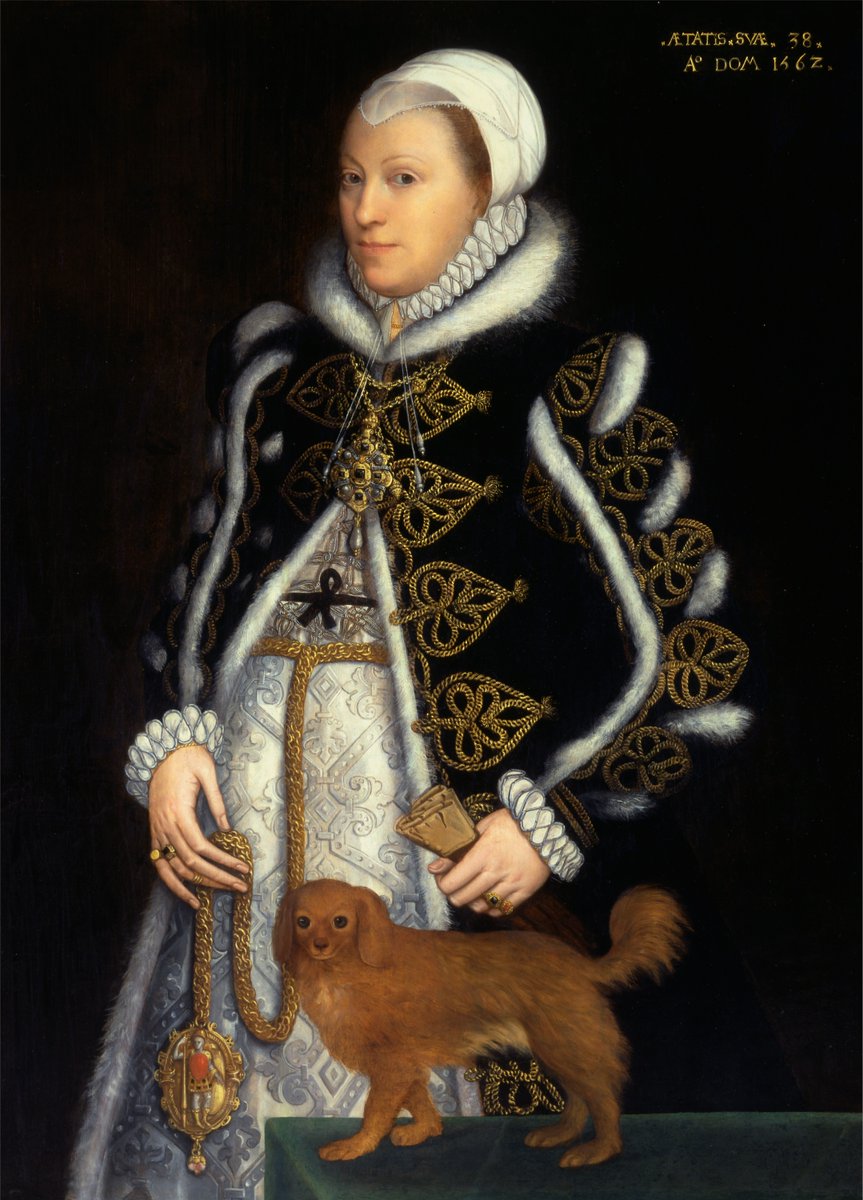
9 - Wherever it actually started, by the early 14th century, velvet-making had spread to Europe, including in Lucca, a city in Northern Italy famed for cloth.
Sadly, the Black Plague ravaged the area, & Lucca’s weavers went to bigger city centers like Venice, Florence & Genoa.
Sadly, the Black Plague ravaged the area, & Lucca’s weavers went to bigger city centers like Venice, Florence & Genoa.
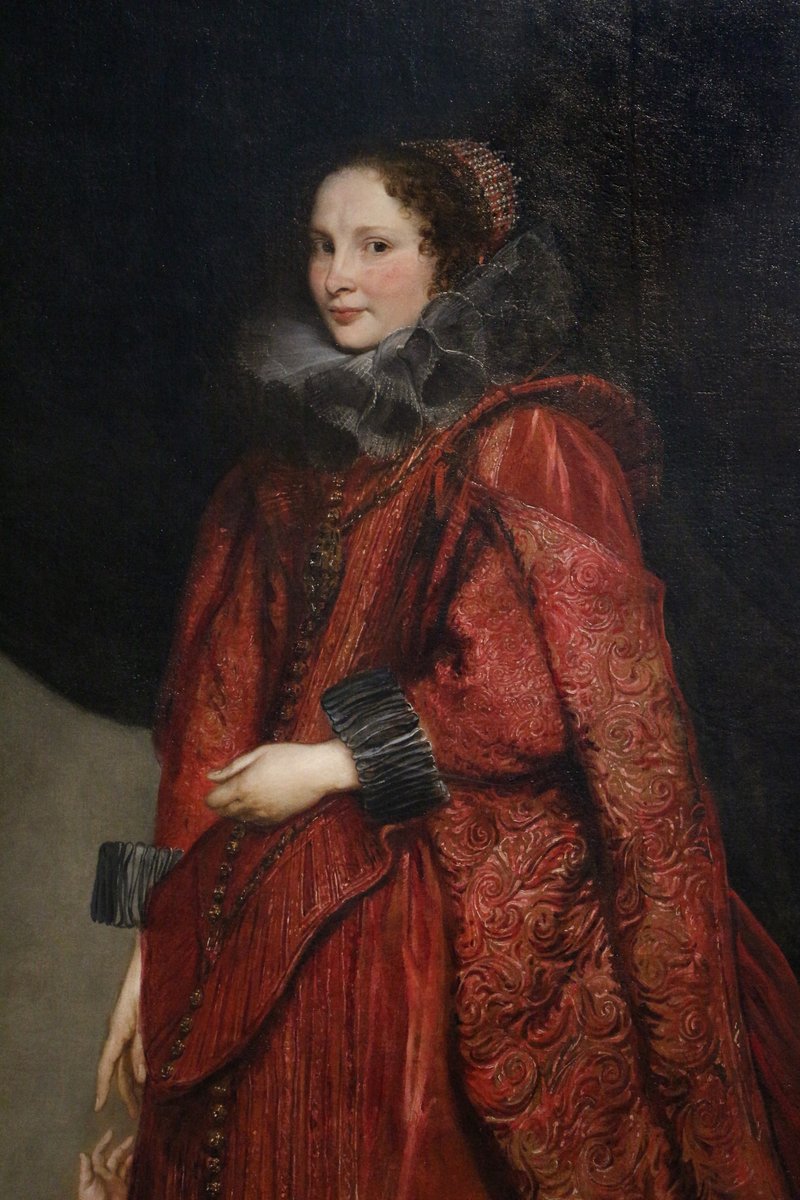
10 - Genoa, also known for its salami, was known far & wide as having some of the finest velvets, but I’m willing to bet there are turf wars all around Italy for that title.
You can still snag some 16th C voided velvet brocade like this one for a mere 30-50K GBP. ::cough::
You can still snag some 16th C voided velvet brocade like this one for a mere 30-50K GBP. ::cough::
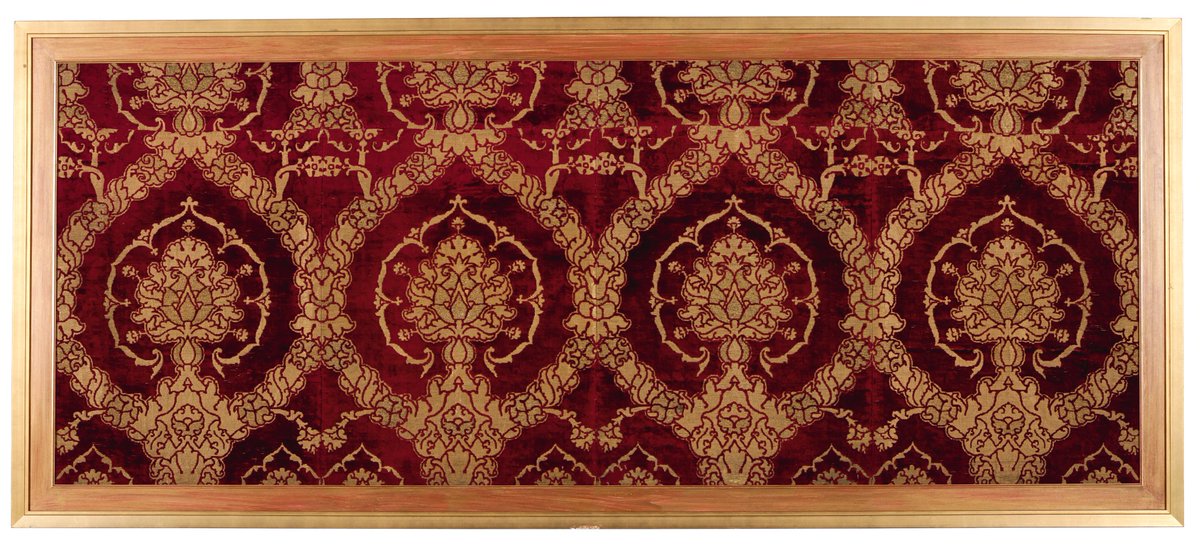
11 - So it makes total sense that this Van Dyck portrait, one of many of his Genovese nobles series, shows Paola Adorno Brignole Sale in cascading deep-blue velvet.
Especially in colder climate locales, nothing quite said opulence like silk velvet to keep you warm.

Especially in colder climate locales, nothing quite said opulence like silk velvet to keep you warm.


12 - Fun fact before we get into some SERIOUS WEIRDNESS (I'm warning you):
Richard II of England, the Lionheart as you may know him, requested that his body be swathed in velvet upon his burial.
Judging by this manuscript from 1400, he may have gotten his wish.

Richard II of England, the Lionheart as you may know him, requested that his body be swathed in velvet upon his burial.
Judging by this manuscript from 1400, he may have gotten his wish.


13 - WEIRD VELVET STUFF.
First, we have the visard or vizard. This mask was made of velvet & nightmares & worn by noble ladies who wanted to go outside and stay super pale. I guess.
It was held in place BY A BUTTON THAT YOU WOULD CLENCH WITH YOUR TEETH. This so sus.

First, we have the visard or vizard. This mask was made of velvet & nightmares & worn by noble ladies who wanted to go outside and stay super pale. I guess.
It was held in place BY A BUTTON THAT YOU WOULD CLENCH WITH YOUR TEETH. This so sus.


14 - Meanwhile in France, the “mouche” ("fly")became a major trend — that is a fake birthmark.
Often made of velvet for its softness & whatnot, these could cover up nasty pox marks & diseased flesh, but could also signal illicit meanings... Wink wink, buzz buzz, seep seep.

Often made of velvet for its softness & whatnot, these could cover up nasty pox marks & diseased flesh, but could also signal illicit meanings... Wink wink, buzz buzz, seep seep.
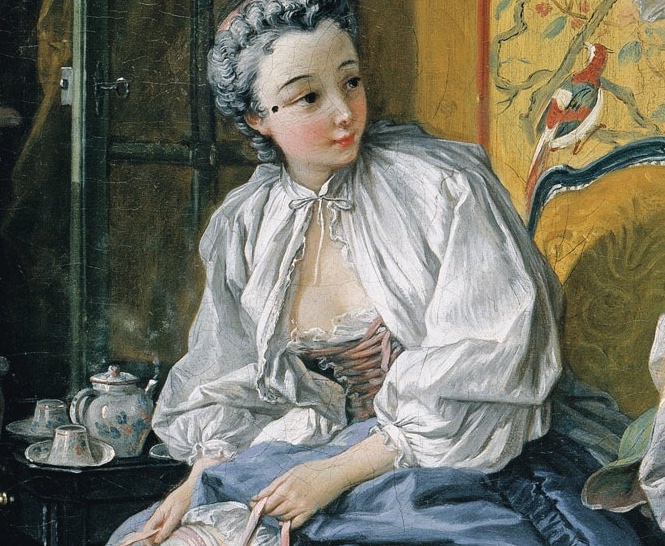

15 - Velvet codpieces were also a thing.
As you do. Because what else would make them out of? No, don't answer that.
Now, the codpiece craze wasn't particularly long or enduring (HAHAHAHA) but it certainly left an impression.
Ahem. Expand image at your own will.
As you do. Because what else would make them out of? No, don't answer that.
Now, the codpiece craze wasn't particularly long or enduring (HAHAHAHA) but it certainly left an impression.
Ahem. Expand image at your own will.

16 - Here. Have a chair. It's a special velvet chair. We need to like, take a breather here.
This is the Juxon Chair, 1661. V & A museum. It was used during the coronation of Charles II William Juxon, Archbishop of Canterbury (1582-1663). Made by a guy named John Casbert.
This is the Juxon Chair, 1661. V & A museum. It was used during the coronation of Charles II William Juxon, Archbishop of Canterbury (1582-1663). Made by a guy named John Casbert.

17 - Our good old friend the Jacquard loom meant more velvet in fashion—but though it was cheaper, it was still extravagant.
We see many hats & dresses with velvet trim in the 19th century, using that light-absorbing technique. This court gown from 1828 is one of my faves.

We see many hats & dresses with velvet trim in the 19th century, using that light-absorbing technique. This court gown from 1828 is one of my faves.


18 - By the mid 19th century, we start to see more experimental velvet piecing, including cut velvet appliqué & really playing with different materials.
This beauty even adds some chenille for some extra pizazz.
GET READY for more FROCKS. It's about to get hot & heavy in here.
This beauty even adds some chenille for some extra pizazz.
GET READY for more FROCKS. It's about to get hot & heavy in here.

19 - Men were wild for velvet & not just because it made for a comfortable codpiece. By the early 18th century you see high-contrast court jackets all over the place.
This teal ensemble matches my hair and I would 100% wear it right now. Look at that TEAL VOID.
This teal ensemble matches my hair and I would 100% wear it right now. Look at that TEAL VOID.

20 - This 18th C jacket from Bukhara, Uzbekistan is a ceremonial woman’s coat (chalet or munisak) and it includes cut-velvet irate on a resist-dyed pile warp.
I love it so, so much.
I love it so, so much.

21 - The 20s ushered in an end era of velvet love particularly in overcoats.
Many of these included devoré silk velvet—which literally means to devour. We now know this as burnout silk. Chemicals used would burn away patterns.
JUST BEHOLD. All from the V&A dating from the 20s.


Many of these included devoré silk velvet—which literally means to devour. We now know this as burnout silk. Chemicals used would burn away patterns.
JUST BEHOLD. All from the V&A dating from the 20s.



22 - Some more velvet fashion that I just can't help but share. Especially the yellow one. I love yellow. And yellow velvet might actually be magical.
But also the blue is basically made of aether. Right?

But also the blue is basically made of aether. Right?


23 - This Pingat cape might be the velvet CAPE OF CAPES. This is clearly owned by a wizard. Or an enchantress. Perhaps Morgan le Fay herself?
This blue is like a song in my brain.
This blue is like a song in my brain.

24 - Okay, one more mantle before I talk about velvet paintings. This one is ... no words. Just inappropriate thoughts.
From 1900, Bon Marché department store in Paris.
From 1900, Bon Marché department store in Paris.

25 - Yes, velvet paintings are a thing! Modern ones are rooted in Mexican and Chicano folk art, it goes back a long time—some attribute India to its invention.
Velvet paintings have been around a long time, though. Here’s one of that’s a George Washington Memorial.
Velvet paintings have been around a long time, though. Here’s one of that’s a George Washington Memorial.

26 - With the invention of polyester fibers, velvet is pretty easy to come by these days.
Good velvet It’s STILL very expensive b/c even with technology, it's super complex. Check this video for more:
qmatex.com/high-tech-weav…
Good velvet It’s STILL very expensive b/c even with technology, it's super complex. Check this video for more:
qmatex.com/high-tech-weav…
27 - There's a lot more I can say, but I've worn out my welcome, just like a good velvet over time. Here are a few more gorgeous dress.
This velvet House of Worth dress combines last week's topic (LACE!) with this week's. That's some full-circle threads there...
This velvet House of Worth dress combines last week's topic (LACE!) with this week's. That's some full-circle threads there...

28 - Time for... Sources! There are a lot. Part I --
google.com/amp/s/handwove…
trc-leiden.nl/trc-digital-ex…
metmuseum.org/toah/hd/velv/h…
digitalcommons.unl.edu/cgi/viewconten…
atelierdesoierie.com/en/refined-vel…
hannahredden.co.uk/single-post/ho…
web.archive.org/web/2010121703…
housebeautiful.com/design-inspira…
sewvintagely.com/2019/05/02/dis…
google.com/amp/s/handwove…
trc-leiden.nl/trc-digital-ex…
metmuseum.org/toah/hd/velv/h…
digitalcommons.unl.edu/cgi/viewconten…
atelierdesoierie.com/en/refined-vel…
hannahredden.co.uk/single-post/ho…
web.archive.org/web/2010121703…
housebeautiful.com/design-inspira…
sewvintagely.com/2019/05/02/dis…
29 - Sources II: hellovintage.com/1920s-velvet-d…
nrfabrics.in/history-of-vel…
refashioningrenaissance.eu/the-renaissanc…
fashionhistory.fitnyc.edu/1625-27-van-dy…
ghorbany.com/inspiration/th…
collectorsweekly.com/articles/sexy-…
en.wikipedia.org/wiki/Visard
jhna.org/articles/gold-…
herald-dispatch.com/features_enter…
cam.ac.uk/research/featu…
nrfabrics.in/history-of-vel…
refashioningrenaissance.eu/the-renaissanc…
fashionhistory.fitnyc.edu/1625-27-van-dy…
ghorbany.com/inspiration/th…
collectorsweekly.com/articles/sexy-…
en.wikipedia.org/wiki/Visard
jhna.org/articles/gold-…
herald-dispatch.com/features_enter…
cam.ac.uk/research/featu…
30 - As always, thanks for coming to my #ThreadTalk! Y'all are the best.
Here's a darling sewing kit. Just to round it out.
Here's a darling sewing kit. Just to round it out.

• • •
Missing some Tweet in this thread? You can try to
force a refresh








